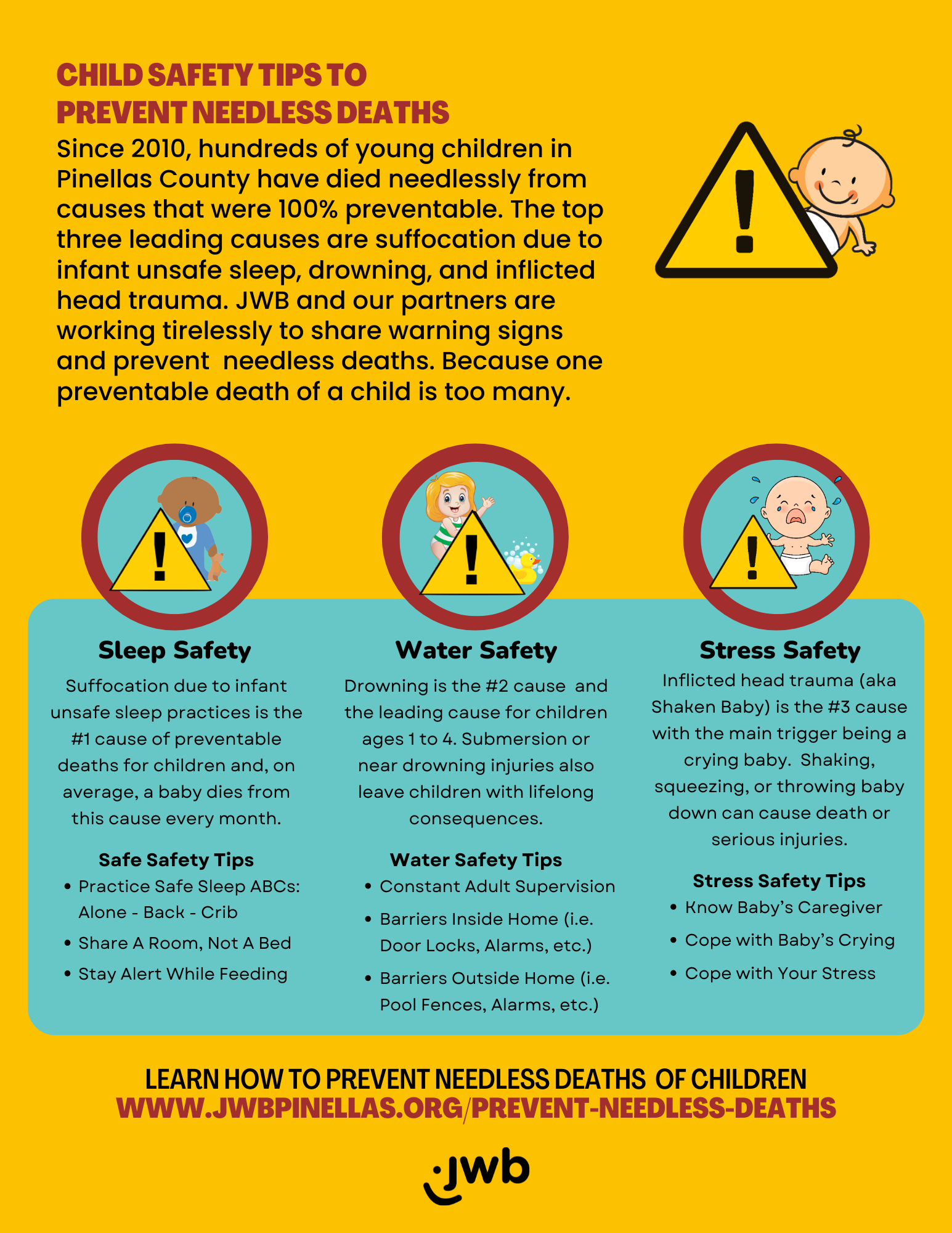Safety Tips to Protect the Littles in Your Life for Baby Safety Month
Sep 03, 2025

During Baby Safety Month and National Childhood Injury Prevention Week (Sept. 1-7), and the Juvenile Welfare Board of Pinellas County (JWB) has facts and tips to share with parents and caregivers of young children.
Download our one-page tip sheet here.
Since 2010, hundreds of young children in Pinellas County have died needlessly from causes that are 100% preventable. This includes the top three leading causes: suffocation due to infant unsafe sleep, drowning, and inflicted head trauma.
JWB and our partners are working tirelessly to prevent these needless deaths because one preventable death of a child is one too many.
INFANT SLEEP SAFETY
Suffocation due to infant unsafe sleep practices is the No. 1 cause of preventable deaths for children. On average in Pinellas County, a baby dies from this cause every single month. We know more today than we used to. We know that sleeping babies alone on their backs in an empty crib, bassinet, or Pack ‘n’ Play with a firm mattress and tight-fitting sheet is safest. Two-thirds of all sleep-related deaths for babies happen in adult beds, mostly from co-sleeping. Another flashpoint is parents or caregivers who fall asleep while feeding baby and accidentally suffocate them.
INFANT SAFE SAFETY TIPS:
- Practice Safe Sleep ABCs: Always sleep baby alone on their back in an empty crib, bassinet, or Pack n’ Play with only a firm mattress and tight-fitting sheet
- Share A Room, Not A Bed: Bring baby’s crib, bassinet, or Pack ‘n’ Play into parents’ room for the first year.
- Stay Alert While Feeding: Sit upright, keep both feet on the floor, and set an alarm while feeding baby.
WATER SAFETY
Drowning is the No. 2 cause of preventable deaths for children and, for tots and preschoolers ages 1 to 4, it is the LEADING cause. In addition, submersion injuries or “near drownings” leave children with long-term consequences and lifetime challenges. Drowning is silent and can happen in just 20 seconds, which is why constant adult supervision is the No. 1 preventive measure. Most children who drown were last seen inside the home which is why barriers inside and outside are also critically important.
WATER SAFETY TIPS:
- Constant Adult Supervision: Inside and outside of the home, the No. 1 preventative measure is constant adult supervision. Designate an adult Water Watcher to keep eyes on children in and around the water. Supervise children during bathtime,
- Barriers Inside the Home: Install door locks and alarms, and keep water sources out of reach from young children (buckets, pet bowls, etc.). Remember to also secure pet doors, as small children can crawl through these as well.
- Barriers Outside the Home: Install pool safety fences, ensure locks on gates to backyard pools, and consider pool alarms. Keep furniture away from pool fences, and keep pool toys out of pool as these attract curious little ones.
STRESS SAFETY TIPS:
Inflicted head trauma (also known as Shaken Baby Syndrome) is the third leading cause of preventable child death of young children. Caregivers who are stressed, exhausted, frustrated, or ill equipped to care for baby may not realize how fragile babies are. Shaking, squeezing, or throwing a baby on a bed or other surface can cause severe or fatal injuries – even one time. These injuries include bleeding on the brain, massive brain swelling, and bleeding inside the eye which may lead to deafness, blindness, brain damage, paralysis, or death. Crying is normal for babies, but it is also the No. 1 trigger for these abusive behaviors. Parents also need to select responsible adults when leaving babies in the care of others and know their own stress limitations.
STRESS SAFETY TIPS:
- Know Baby’s Caregiver: Know who the person is that cares for your child and ask yourself a series of questions about their temperament, judgement, and expectations of your child. Allow only responsible adults to care for children and use only licensed childcare centers or homes.
- Cope with Baby’s Crying: Understand crying is normal, it’s how babies communicate, and it’s not harmful to baby (but shaking a baby is!). Learn ways to soothe baby: swaddle, rock, cuddle, sing, or take baby for walk.
- Cope with Your Stress: Understand your own stress limitations as baby’s caregiver and find ways to cope. Put baby down in a safe environment, then walk away. Listen to music or phone a friend. Check in on baby periodically to ensure safety. Create a safety plan that includes others you can call when you need a break.
Learn more at JWBPinellas.org/prevent-needless-deaths
